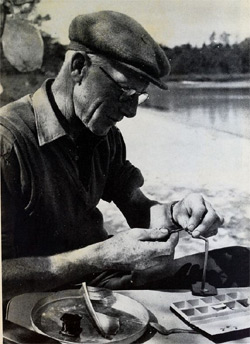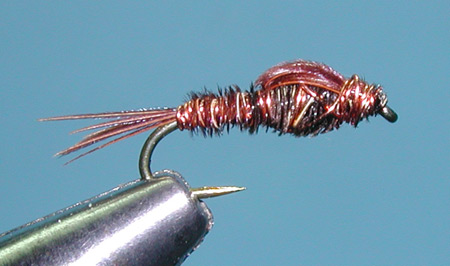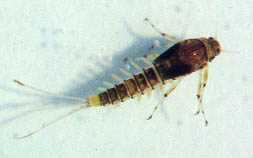|
Notes:
 The Pheasant Tail Nymph (PTN) is a design of Frank Sawyer, who was the River Keeper of the Avon River at Lake House in England starting in 1925. Then, three years later, Frank signed on with a club of British military officers known as the Services Dry Fly Association, a position he held until 1980. The Avon was in terrible condition with mud and silt until Frank dredged the bottom in the 1950's returning the river to it's original chalk and gravel. The PTN was also designed in the 1950's to imitate the baetis hatches now occuring on the Avon and he published the pattern within his book, Nymphs and the Trout, in 1958. Frank was using an earlier pattern called the Pheasant Tail Red Spinner dry fly and noticed how the fish would take the pattern after it sunk. This gave him the inspiration to come up with something new. To keep the sillouette slender, Mr. Sawyer used only two materials: fine copper wire and 4 Pheasant Tail Fibers. The shape allowed the fly to quickly sink with the weight of the wire, the few fibers gave the appearance of legs and tails. Frank liked to let the fly sink and lift his rod tip to "swim the pattern" to the surface. Terry Lawton had a very good article on tying the original Frank Sawyer PTN in Flyfishing & Tying Journal, Fall 2007. He pointed out that Frank finished his nymphs with a whip finish of the wire behind the thorax. This was confirmed by Frank's daughter, Pat, although the rest of the family preferred to finish the nymph behind the eye. Today, most Pheasant Tail Nymphs (PTN), in the Sierra, tend to be larger with somewhat more materials to imitate the Callibaetis, Blue-wing Olives, March Browns and other mayflies that frequent our streams. An actual video of Frank tying the pattern in the 1950's is at the base of the page. Another great video is Hans Weilenmann showing how to tie the pattern in 2012. The Pheasant Tail Nymph (PTN) is a design of Frank Sawyer, who was the River Keeper of the Avon River at Lake House in England starting in 1925. Then, three years later, Frank signed on with a club of British military officers known as the Services Dry Fly Association, a position he held until 1980. The Avon was in terrible condition with mud and silt until Frank dredged the bottom in the 1950's returning the river to it's original chalk and gravel. The PTN was also designed in the 1950's to imitate the baetis hatches now occuring on the Avon and he published the pattern within his book, Nymphs and the Trout, in 1958. Frank was using an earlier pattern called the Pheasant Tail Red Spinner dry fly and noticed how the fish would take the pattern after it sunk. This gave him the inspiration to come up with something new. To keep the sillouette slender, Mr. Sawyer used only two materials: fine copper wire and 4 Pheasant Tail Fibers. The shape allowed the fly to quickly sink with the weight of the wire, the few fibers gave the appearance of legs and tails. Frank liked to let the fly sink and lift his rod tip to "swim the pattern" to the surface. Terry Lawton had a very good article on tying the original Frank Sawyer PTN in Flyfishing & Tying Journal, Fall 2007. He pointed out that Frank finished his nymphs with a whip finish of the wire behind the thorax. This was confirmed by Frank's daughter, Pat, although the rest of the family preferred to finish the nymph behind the eye. Today, most Pheasant Tail Nymphs (PTN), in the Sierra, tend to be larger with somewhat more materials to imitate the Callibaetis, Blue-wing Olives, March Browns and other mayflies that frequent our streams. An actual video of Frank tying the pattern in the 1950's is at the base of the page. Another great video is Hans Weilenmann showing how to tie the pattern in 2012.
Probably one of the most popular variations for the Sierra is the Peacock Thorax by Al Troth using peacock herl for the thorax. This pattern is also known within the United States as the Pheasant Tail Nymph (American version).
The Flashback Pheasant Tail is a variation by Andre Puyans with the addition of a flashabou strand over the top of the Peacock Thorax to simulate the sparkle caused by gases trapped under the skin of a mature nymph as it rises to the surface to transform into the winged dun. Andre Puyans also utilized the butt ends of the Pheasant Tail fibers to create small appendage-type legs. Andre was also one of the first to incorporate a gold bead to the fly. Substituting brown thread and using a wire ribbing is also commonplace on most of the PTN's purchased today.
Adding a bead to the pattern compensates for the lack of copper wire within the thorax and allows the pattern to sink rapidly. Some tiers will extend the strand to the top of the abdomen as a crackleback. This pattern can be effective without a bead to present the nymph near the surface or with a bead to get further down into the water column.
Dean Endress, of Fishermen's Spot, came up with his Robo PT in the early 1990's. He uses a Copper and Dark Green Lite Brite blend for the thorax with a flashback of flat Pearl Mylar or strands of Holo Silver Mylar over a Pheasant Tail Fiber underwing. He's been sustituting brown or black scudback for the underwing lately. Dean also uses UV Knot Sense to coat the mylar flashback. The fly is marketed by Solitude Fly Company
and has been very popular within Sierran streams. Another varitation is the Hot Spot PTN which uses a bright colored dubbing such as an Orange/Pink SLF dubbing for the thorax. This "hot spot" has been effective on many of the Euro Nymph patterns and is also effective on standard nymphs such as the Pheasant Tail.
The Poodle Sniffer that was designed by David Palmer when he was the head guide at Big Horn Anglers around 2012. This pattern mimics the small Black Caddis that frequent Sierran streams during the summer months. The trigger on this fly is the chartreuse wire over a black dyed Pheasant Tail. It fulfills the criteria of most guide flies, easy to tie and they work. Another good pattern for the black caddis is the BH Poxyback PTN also using Black dyed Pheasant Tail. The bead helps get this fly deep within the water column.
|



